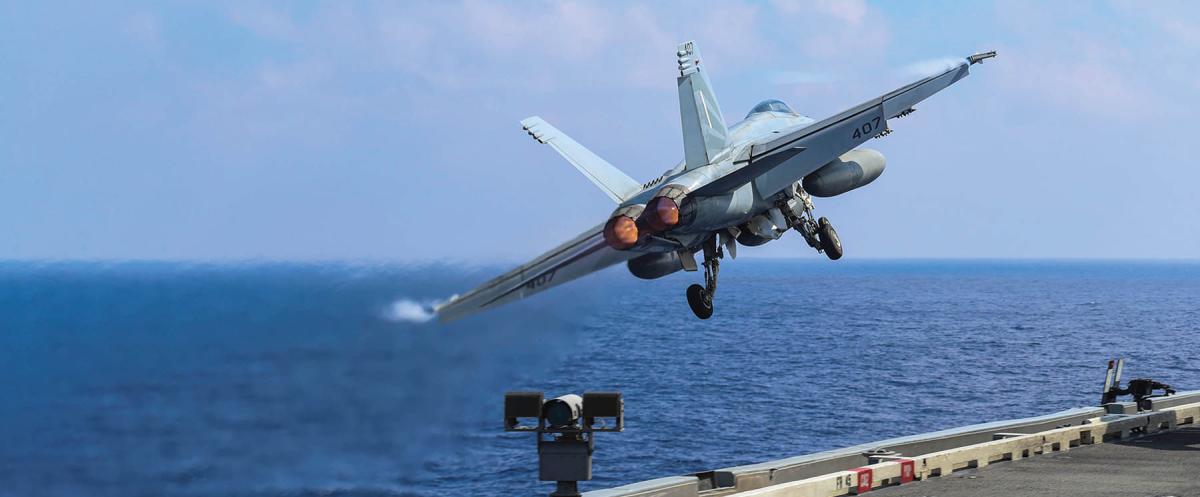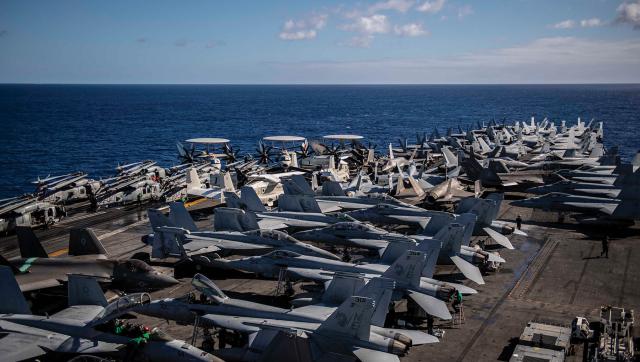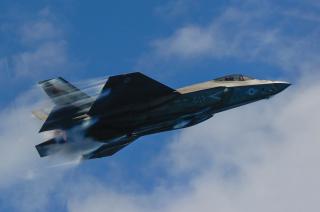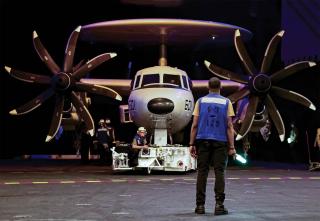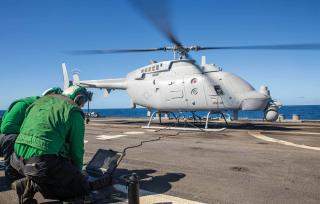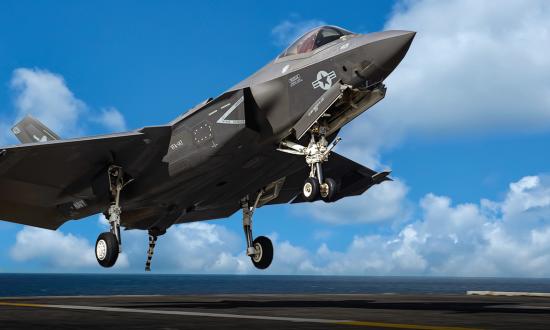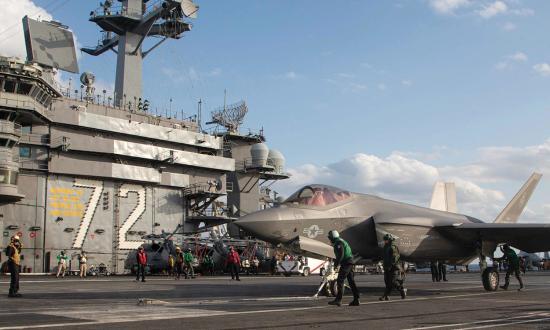What a difference a year makes.
In last year’s review, the focus aligned clearly with a multiyear push by the U.S. government: recognizing China as the long-term pacing threat and aligning planning and procurement efforts to meet the looming multidecade challenge.
Then 2022 got a vote. Russia invaded Ukraine, focusing the near-term spotlight squarely on Europe. This alone caused a lengthy delay to rewrite portions of the 2022 National Defense Strategy before its public release.
Midterm elections yielded a divided Congress, leading to an immediate fight over curbing federal spending, with the nation’s debt ceiling, and possible default, as the backdrop. This political theater—holding debt obligations hostage to relitigate prior year congressional budgets—is at best a distractor, at worst a harbinger of unneeded economic uncertainty.
All while technological advances continue apace, raising new questions about the future character of warfare and, accordingly, overall force design.
As goes the refrain overheard in every naval aviation unit: “The only constant is change.”
Threat Assessment
The Russo-Ukrainian war illuminates some incredibly telling realities following 12 months of conflict: Antiaccess capabilities are real, drone and low-cost warfare is effective, and Russia is not the superior ten-foot-tall military giant the world thought it was.
The first two present significant ramifications for naval aviation strategists and force designers, highlighting the reality that every planning consideration is a hypothetical until it is proven. Despite Ukraine’s surface-to-air and man-portable antiaircraft missiles, the initial conjecture in early 2022 was that Russian aviation would quickly “roll back” Ukraine’s integrated air-defense systems and establish control in the sky, enabling tanks and infantry units to roll across the country en route to Kyiv. Not so.
In fact, quite the opposite. Ukraine quickly and repeatedly spurned technologically superior Russian combat jets and helicopters, denying access while completely changing the tide of war. Ukrainian airspace still is largely inaccessible to Russian aircraft, leaving Russian ground units at significantly higher risk as the conflict enters its second year. In addition, Ukrainians have put unmanned aerial vehicles to use in increasingly sophisticated and effective ways.
Naval aviation implications are legion. On one hand, allies and partner nations woke from their slumber once faced with a nakedly aggressive Russian state and increasingly expansive Chinese intentions. NATO nations are now increasing military spending while sending matériel to Ukrainian front lines. So, too, are Japan and South Korea in the Indo-Pacific, as they contend with China in their backyard. Increased military spending by U.S. allies is a long-sought goal.
On the other hand, Ukraine’s effectiveness at denying air superiority to a much larger, better resourced, and technologically advanced foe bodes poorly for naval aviation.
China continues to develop and field significant antiaccess/area-denial weapons along with an extensive land-, sea-, air-, and space-based surveillance network. These capabilities, together with a large conventional armed force and ballistic missiles, make entering and operating within the first and second island chains prospectively a relative nightmare.
Naval forces likely could do so but only when the full spectrum of U.S. power is brought to bear: cyberattacks; long-range conventional missiles targeting Chinese bases, piers, and launchers; denial of space-based assets; and much more. Until that point, naval forces and, by extension, naval aviation, will operate from a precarious position. The Russo-Ukrainian war highlights the weaknesses facing aviation assets operating against a localized force with solid antiair capabilities.
The prolific use of drones also highlights a changing calculus. Why employ incredibly expensive assets and place aviators at risk when similar outcomes can be achieved with lower cost and more readily replaceable, and relatively effective, unmanned aerial vehicles? Many nations have dabbled in the unmanned aircraft space. The Russo-Ukrainian war should have developers racing to their whiteboards to rapidly expand these capabilities.
Then there are the fiscal realities. Explosive cost growth during the past few decades makes fielding advanced equipment at strategically significant quantity a difficult task. Moreover, while the private sector continually refines and improves its products, the defense sector typically requires new contracts—at significantly higher cost to U.S. taxpayers and lengthy developmental delays—to incorporate similar capability enhancements. Such an approach slows innovation while driving up prices, placing additional pressure on an already challenged federal budget. In turn, the U.S. military can field fewer units, which forces difficult employment decisions.
Likewise, playing fiscal chicken with the debt ceiling risks continued instability in military funding. The 2011 Budget Control Act and 2013 budget sequestration—coupled with a long series of continuing resolutions—crushed military readiness. Once training and material readiness degrades, adding money back in does not immediately address the problem. Rather, it takes years to rebuild lost training, restore affected supply chains, and sort through the “haves and have nots” on the personnel front. Fiscal stability in 2023 and beyond is not just a “nice to have”—it is a necessity.
Missiles during a training exercise near Guam. The Growler’s software is updating to
the H16 version, which will bring improved radar capabilities and display enhancements. U.S. Navy (Peter Scheu)
One element that remains unchanged from 2021 is the continuing necessity to rapidly develop, adopt, and deploy advanced technologies. Prime among these are data collection, storage, analysis, and distribution, which remain obstacles that delay significant military advancements.
Sure, data links of varying types continue to enable greater capabilities. Aircraft can illuminate targets that are then intercepted by ship-launched missiles. Some weapons can be selectively retargeted while in flight or handed off to another platform for terminal guidance. Platforms can also share a general awareness with others, aiding the creation of a common operating picture.
But one look at the commercial sector forces a realization of just how far behind the military is when exploring the full capabilities available from exploiting data streams already in service.
Obvious ethical questions aside, the commercial sector has engineered a massive industry around collecting as much information as possible, analyzing and cross-referencing this information, then selling it to anyone seeking such insights: advertisers, large corporations, insurance companies, law enforcement, and others. Cell phones continually upload users’ precise location, apps track interests and usage, credit card companies track purchases, and much more. Insights are limitless. These will only grow more prolific with time when coupled with an increasingly endemic “internet of things.”
With large numbers of military aircraft, vessels, and units collecting data on a continual basis, it is shocking the Department of Defense is still far removed from current private-sector capabilities. Massive amounts of data are collected but rarely processed, shared, and then put to good use on a meaningful scale. Thankfully, leaders such as Deputy Secretary of Defense Kathleen Hicks have made data superiority a priority, but tomorrow’s timeline lags today’s need. This is an area still ripe for rapid exploration, in which greater domain awareness and knowledge can amplify the impact of numerically shrinking military units.
Despite 2022’s curveballs, the strategic calculus remains clear: China remains the U.S. pacing threat; growing Chinese-Russian alignment is still a concern; and naval aviation capabilities must take full advantage of available low-hanging fruit: data aggregation, analysis, and sharing; increased payload-to-platform pairings; and innovative approaches using existing resources.
Platform and Payload Updates
With a clear-eyed view of maritime challenges, Navy planners continue to make incremental improvements throughout the naval aviation enterprise. The following updates benefit greatly from the January 2023 Director of Test and Evaluation Report made available to the public—a break from recent years when the report went only to Congress.1
The Navy’s newest flagship, the USS Gerald R. Ford (CVN-78), continues to move toward full operational capability following its 2017 commissioning and 2021 initial operating capability declaration, a path now expected to be achieved by the end of 2024. The Gerald R. Ford spent 84 days underway in 2022, continued to practice integration with her associated carrier air wing, and completed her first six-month planned incremental availability maintenance period. System reliability remains a concern for the Gerald R. Ford–class carriers, specifically related to electromagnetic catapults, advanced arresting gear, jet blast deflectors, and radar systems. The ship has conducted more than 10,826 catapult launches and arrested landings to date.2
The first four ships in the class are now accounted for, with the John F. Kennedy (CVN-79) expected in 2024 and contracts for the future Enterprise (CVN-80) and Doris Miller (CVN-81) signed in January 2020, with delivery slated for 2028 and 2032, respectively.
In April 2022, the U.S. Navy submitted its shipbuilding plan to Congress with three alternative programs: The first two show tradeoffs in the number of war-fighting ships, while the third presents an increased force structure should additional funding be made available. The Navy’s plan, evaluated in a November 2022 Congressional Budget Office analysis, suggests a path to reduce the current number of aircraft carriers from today’s 11 (ten Nimitz class and one Gerald R. Ford class) to 10 or even 9 to better address Navy desires for a more distributed fleet structure.3
The Navy maintained its increased carrier presence in the Indo-Pacific as three of the four U.S.-named strategic competitors—China, Russia, and North Korea—reside in the region. In February, the USS Carl Vinson (CVN-70) and Nimitz (CVN-68) transited together in the Pacific Ocean, the Abraham Lincoln (CVN-72) conducted an Indo-Pacific deployment, and the Ronald Reagan (CVN-76) continued to provide presence as part of the Navy’s Japan-based Forward Deployed Naval Force.
Aircraft carriers visibly remain as a rapid response capability. When Russia invaded Ukraine on 24 February 2022, Defense Secretary Lloyd Austin diverted the USS Harry S. Truman (CVN-75) from her planned Middle East rotation, instead keeping the strike group in the Mediterranean Sea to support Sixth Fleet operations and bolster European security presence.
Naval aircraft capabilities continue to evolve with the Block III Super Hornets. Block III improvements include a longer airframe life—10,000 flight hours versus Block II’s 6,000 flight-hour limit. Block III also is built for significantly increased networking and data-sharing capabilities with the Distributed Targeting Processor-Networked (DTP-N) mission computer. All these elements are designed to extend the useful life of the Super Hornet fleet while meeting advancing warfare requirements. A total of 78 Block IIIs are expected.
The F-35 Lightning II Joint Program Office continued production, system upgrades, and testing in 2022. Block IV software capabilities will be the first to provide a complete weapon suite for the airframe. These updates introduce an additional 14 weapons to the aircraft, including “dual use” nuclear capabilities to enable the F-35 to carry B61-12 air-dropped nuclear bombs. Lockheed Martin also is on track to begin updating older F-35 airframes with Technology Refresh 3 capabilities in 2023, a process that will increase the jet’s overall computing power.
The total number of F-35s is expected to reach 2,456 aircraft across all U.S. service branches (273 carrier-based “C” variants are planned for the Navy and 353 “B” and 67 “C” variants for the Marine Corps).4 The Joint Strike Fighter program anticipated moving into full-rate production by 2022, but program delays and cost growth have pushed that decision back until summer 2023 at the earliest.5 The F-35 program office also is being dissolved, with Congress requiring functions be distributed to the Air Force and Navy by 1 October 2027.
Lockheed Martin announced in April that the F-35 fleet had surpassed 500,000 global flight hours.6 The carrier-based version, the F-35C, finished its first deployment on board the Carl Vinson in February 2022. A part of the “air wing of the future,” the deployment also included CMV-22 Osprey carrier onboard delivery, EA-18G Growler, and E-2D Advanced Hawkeye aircraft.
EA-18G Growler electronic-attack and E-2D Advanced Hawkeye early-warning aircraft also are evolving as new capabilities become available. The EA-18G’s software, now aligned with the F/A-18’s, is updating to the H16 version to provide greater utility to crew members and data sharing between aircraft and with other platforms. H16 software also brings improved capabilities to the APG-79 radar along with display advancements. Overall, the ability to update software while retaining the same hardware enables the Navy and Marine Corps to evolve in a way not available in previous decades, a potential game-changer in today’s rapidly changing operational environment.
Likewise, the E-2D brings significant improvements over the “Charlie” version it is replacing, including an AN/APY-9 hybrid phased-array/rotating dome radar, a tactical targeting network datalink, satellite communications, and inflight refueling to extend its time aloft. The spinning phased-array radar enables E-2D crews to retain excellent situational awareness to the operational picture, provides an enhanced ability to track specific targets, and provides a greatly improved ability to discriminate in ground clutter. This becomes critical when operating in challenging conditions, such as where the sea meets the shoreline or in mountainous terrain. E-2D software will continue to incorporate enhancements to make the tracking and sharing of targets even better with time.
Rotary-wing squadrons continue to follow the Future Vertical Lift (FVL) program that will see a combination of manned and unmanned aircraft, like the Navy’s approach for the Next Generation Air Dominance program. The MQ-8C Fire Scout is an unmanned helicopter designed to support intelligence, surveillance, and reconnaissance missions. The MQ-8C onboard radar provides the ability to survey large areas of sea space, improving over-the-horizon capabilities for smaller surface combatants. Additional packages undergoing testing will provide future surface warfare and mine countermeasures capabilities.
The P-8A Poseidon—the Navy’s primary long-range antisubmarine, antisurface warfare, and intelligence, surveillance, and reconnaissance platform—is still testing the Mk 54 torpedo with the High Altitude Anti-Submarine Weapon Capability (HAAWC) guidance kit, an accessory wing that enables high-altitude torpedo launch. Once HAAWC achieves operational status, this capability must be extended to the F/A-18E/F to increase antisubmarine warfare capabilities for the carrier air wing, especially when operating in contested sea space. While torpedoes have long been limited to maritime patrol and rotary-wing aircraft, it is only prudent to expand their availability and use to nontraditional platforms, especially given China’s significant investment in submarines and other vessels.
Naval aviation also needs to move swiftly on the MQ-25 Stingray—a carrier-launched unmanned aircraft—and the MQ-4C Triton, which can provide broad area maritime surveillance. These platforms can serve as significant enablers to today’s force, but their development and fielding lags that of other nations. There is plenty of opportunity to make these platforms more autonomous as both still require a significant amount of manual intervention.
The Navy’s 2023 naval force is well-positioned to excel, but its capability and capacity gap is shrinking when compared with that of China’s navy, its most significant pacing threat. Platforms and their corresponding weapon and sensor payloads require significant investment to maintain pace. Doing so will ensure today’s force can meet the nation’s needs not only during times of conflict, but also during the critical intelligence-gathering phase that enables policy-makers, allies, and military leaders to make well-informed decisions. The need to amplify current capabilities to meet future needs is legion—but will the United States seize the opportunity?
1. Nickolas H. Guertin, Operational Test & Evaluation Annual Report (Washington, DC: Department of Defense Operation Test and Evaluation Office, January 2023).
2. Guertin, Operational Test & Evaluation Annual Report, 166.
3. Congressional Budget Office, An Analysis of the Navy’s Fiscal Year 2023 Shipbuilding Plan (November 2022).
4. Congressional Research Service, F-35 Joint Strike Fighter (JSF) Program, Updated 2 May 2022.
5. Valerie Insinna, “Full Rate Production for F-35 Is at Least Another Year Away,” Breaking Defense, 8 March 2022.
6. “750 F-35s in Service as 2022 Begins, Lockheed Martin Says,” Seapower Magazine, 3 January 2022.



